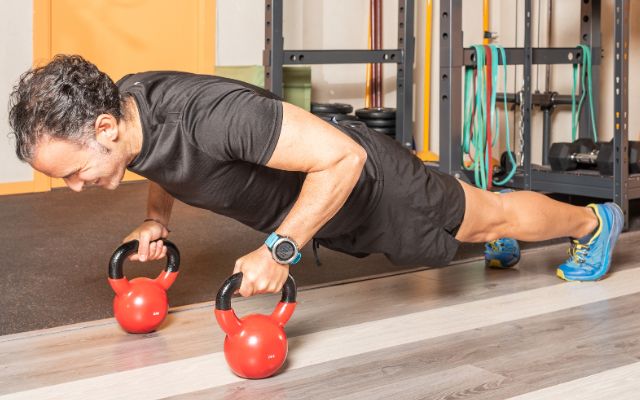This post provides a comprehensive kettlebell chest workout designed for beginners, intermediates, and advanced users. I’ll bring you through a safe and effective program, incorporating various exercises, modifications, and crucial safety considerations to help you achieve your fitness goals.
Warm-up (5-10 minutes)
General Mobility
A proper warm-up is paramount for injury prevention and optimal performance. Begin with general mobility exercises like arm circles (forward and backward), shoulder rotations, and wrist rotations. These movements increase blood flow to the targeted muscles, preparing them for the demands of the workout.
Dynamic Stretches
Dynamic stretches are vital for enhancing flexibility and range of motion. Include exercises like backward arm swings, torso twists, and high plank shoulder taps. Dynamic stretches improve joint mobility and help prevent muscle stiffness during the workout, promoting smooth movements and reducing the risk of injury.
Kettlebell Chest Exercises & Variations (45-60 minutes)
Push-Up Variations (3-4 rounds)
Push-ups are foundational chest exercises. This section provides modifications for various skill levels. Beginners can start with knee push-ups on a kettlebell, gradually increasing difficulty by progressing to standard push-ups on a kettlebell, and ultimately to full push-ups. Each variation is designed to challenge the chest muscles gradually, promoting proper form and preventing injury.
Beginner
Beginning with a kettlebell on the floor, place one hand on the kettlebell. Maintain a straight line from head to heels as you lower your chest towards the kettlebell, focusing on a controlled descent and ascent. Maintain a strong core throughout the exercise. Always prioritize form over speed, focusing on squeezing your chest muscles at the top of each rep.
Intermediate
Progress to standard push-ups on the kettlebell, performing them with one hand on the kettlebell, and alternating hands. Maintain proper form, emphasizing a controlled descent and ascent. Ensure your elbows are tucked in and away from your body during the movement, engaging the chest and avoiding straining the shoulders.
Advanced
Perform full push-ups using both hands on the kettlebell. A key focus is maintaining a stable core to keep your body aligned and prevent excessive stress on your spine. Use proper form to prevent injuries.
Variations
Incline and decline push-ups, along with diamond push-ups, add variety and challenge to your workout. These modifications allow for increased intensity and a greater focus on different areas of the chest muscles.
Kettlebell Chest Press (3 sets of 8-12 reps)
Lie on your back with the kettlebell held over your chest. Press the kettlebell up, extending your arms fully and squeezing your chest muscles at the top. Return to the starting position in a controlled manner. This exercise directly targets the pectoral muscles for strength and hypertrophy.
Variations
Incline or decline chest press variations target different sections of the chest muscles, providing a more comprehensive chest workout. One-arm variations add an element of unilateral training, ensuring both sides of your chest develop evenly. Experiment with these modifications to suit your preferences and progress.
Kettlebell Chest Flyes (3 sets of 10-15 reps)
Lie on your back with the kettlebell held over your chest. Lower the kettlebell out to your sides in a controlled motion, feeling the stretch in your chest muscles. Return to the starting position, squeezing your chest muscles at the top. This movement targets the upper chest and helps build the overall size and strength of the pectoral muscles.
Variations
Incline or decline chest flyes enable isolation of specific sections of the chest. Performing one-arm kettlebell flyes isolates each side of the chest, promoting even development and balanced strength.
Pullovers (3 sets of 10-15 reps)
Lie back, holding the kettlebell over your chest. Extend your arms back fully, lowering the kettlebell towards the floor. Return to the starting position. This exercise is more complex, including the upper chest, shoulders and triceps. The proper form of this exercise includes a stable core to prevent injury and maintain the target muscles being worked.
Variations
Using an incline position will further target the upper chest. Adjustments to the position and grip can alter the focus of this exercise to better align with specific chest muscle goals.
Superset – Chest Press and Triceps Extensions (3 sets)
Alternate between chest press and triceps extensions for maximum efficiency and fatigue, focusing on both upper and lower chest and triceps. This superset targets multiple muscle groups in a single circuit, minimizing rest time between exercises.
Cool-down (5-10 minutes)
Static stretching is essential for improving flexibility and reducing muscle soreness after a workout. Focus on stretches targeting the chest, shoulders, and triceps. Hold each stretch for 20-30 seconds to allow your muscles to recover and promote flexibility and range of motion.
Kettlebell Chest Workout 20 Minutes At Home
Progression & Safety
Adjust weight selection based on your experience and form. Maintain correct form throughout all exercises to prevent injuries. Modify exercises as needed and always prioritize your safety.
Additional Considerations
Proper nutrition and a balanced diet are crucial for supporting muscle growth. Combining this chest workout with other full-body training days will enhance your overall strength and development. Listen to your body and adjust the workout to fit your needs and goals.
Workout Structure & Schedule
Schedule 1-2 chest workouts per week, allowing sufficient rest for muscle recovery. Adjust the duration based on your experience and fitness level, focusing on the intensity and maintaining proper form. Focus on the intensity and proper form to maximize results without risking injury.
Kettlebell Specific Concerns
Proper grip techniques are essential for minimizing the risk of slippage. Choose a kettlebell weight that aligns with your current strength level to maximize safety and results. It is always best to start lighter and increase the weight gradually as you get stronger.








